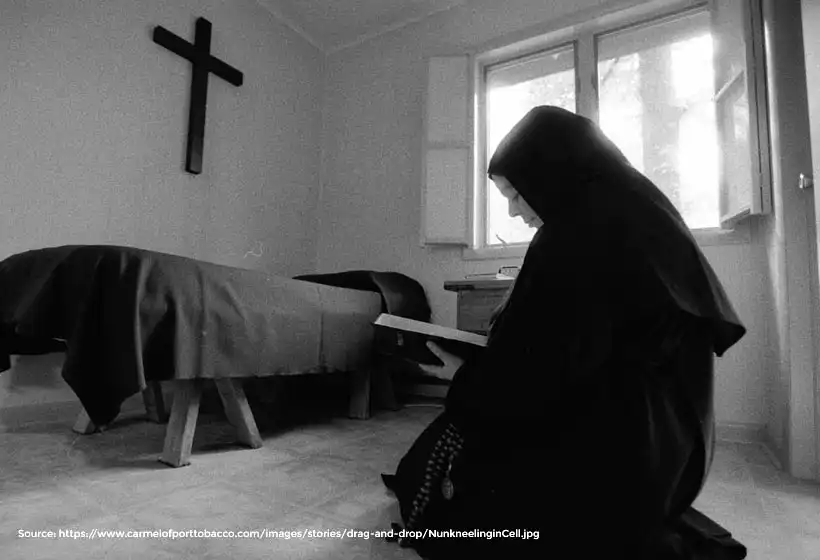THE NUN: Know Their Mysterious Sleep Schedules

Imagine walking through silence. Dimly lit convent in the middle of the night, where shadows seem to move. The air feels heavy with mystery.
Nuns, known for their quiet and disciplined lives, have always fascinated us. Their strict routines, including their unusual sleep schedules, stand out.
It is much like the eerie atmosphere. Darkness hides secrets. Sleep habits of nuns carry an air of intrigue.
The movie, THE NUN, takes us into a world filled with supernatural fear. In real convents, daily lives of nuns revolve around devotion and rituals. It influences how and when they sleep.
Let’s explore the mysterious and sacred sleep schedules of nuns!
Before that, if you want to understand sleep habits of nuns, you must look back at the history of monastic life. Let’s find out!
What is the Historical Origin of Monastic Sleep Patterns?
As a way of life, monasticism began to grow in the early centuries of Christianity. The first monks and nuns lived very simple lives. Fasting for long periods of time, sleeping very little, and praying for long periods of time were part of their life.
Their goal was to give up all comforts of this world. They focus only on their spiritual journey.
In the third and fourth centuries, a group of early Christian hermits called Desert Fathers. They lived in the Egyptian desert. They thought that sleep was a sign of a weak body. So, they would often wake up in the middle of the night to pray.
This practice set the stage for what would later become the normal sleep routine for nuns.
Know more about the origin and purpose of the monastic movement!
Sleep schedule of nuns is deeply rooted in monastic traditions. Their day and night are divided between sleep and prayer. Let’s talk about their sleep schedule!
Sleep Schedules of Nuns

How Nuns Divide Their Day? The Canonical Hours
Sleep schedules of nuns revolve around Canonical Hours. These are specific periods of prayer. They provide the framework for the nun’s entire daily routine, including sleep.
The structure of Canonical Hours varies slightly among different religions. This ancient tradition goes back to the early centuries of Christian monasticism. The hours are as follows:
- Matins (Vigils) – Midnight or very early morning
- Lauds – Early morning, often around sunrise
- Prime (optional) – Mid-morning
- Terce – Midday (around 9 a.m.)
- Sext – Noon
- None – Mid-afternoon (around 3 p.m.)
- Vespers – Early evening
- Compline – Nightfall, before bed
Nuns’ sleep is often segmented around these times of prayer. Let’s explore how this schedule impacts their sleep patterns.
1. Nighttime Disruptions: Matins and Early Morning Lauds
The most unique aspect of a nun’s sleep schedule is the nighttime prayer known as Matins This prayer typically takes place in the middle of the night, often around 3 a.m.
It naturally disrupts a nun’s sleep. After finishing prayers, nuns might return to their cells (dormitories) for a few more hours of rest. They rise again for Lauds, the early morning prayer that takes place at or before sunrise. Hence, the nuns’ total amount of sleep is often split between the time before Matins and the period before Lauds.
This biphasic sleep pattern is a hallmark of monastic life. It sets it apart from typical continuous sleep most people experience.
2. The Evening Routine: Compline and Sleep
The nun’s sleep schedule begins with evening prayer. It is known as Compline. This prayer is held just before bedtime.
After Compline, nuns retire to their cells for sleep. The amount of rest they get before the first interruption for Matins can vary. It is usually between two to four hours. This is the first segment of sleep in their nightly routine.
The nuns aim to balance their need for rest with their spiritual obligations. It is often a shorter and more broken form of rest.
3. Daytime Rest: Naps and Short Breaks
Despite fragmented nighttime schedule, nuns may take short naps. These naps are often aligned with the periods between the daytime prayers. It is after Terce (mid-morning) or before Vespers (early evening).
These short periods of rest are not long enough. However, they help the nuns to maintain their energy levels throughout the day.
Unlike a traditional siesta, these naps are often very brief. It lasts 15-30 minutes. These are taken when time allows between prayers, work, and study.
In this way, the nuns’ sleep schedule is polyphasic. Their total sleep is spread across multiple segments throughout the day and night.
4. Special Religious Seasons: Adjustments to Sleep
During religious seasons like Lent or Advent, nuns may further adjust their sleep schedules These periods often require even more sacrifice. The nuns may sleep even less than usual.
During Lent, nuns may rise earlier for additional prayers. This reduces their total hours of sleep. This increased focus on prayer and spiritual discipline This can lead to a schedule where sleep becomes an even smaller portion of the day.
For more information, read about the superior sleep of healthy elderly nuns!
The Role of Sleep in Monastic Life Today
Sleep schedules of nuns have remained rooted in tradition. Many convents now allow nuns to get longer periods of sleep during the night. Though it is still fragmented by canonical hours.
The intensity of sleep schedule may also vary depending on religious order. It depends on the nun’s level of spiritual maturity.
Health Implications of The Nun’s Sleep Schedule
The fragmented sleep schedule of nuns raises questions about the health implications Interrupted sleep, as experienced by nuns, can lead to sleep deprivation. This may impact cognitive function, mood, and immune health.
However, nuns often report that their spiritual practices provide them with a sense of peace. It offsets any physical discomfort from lack of sleep. Their deep sense of purpose and inner calm may serve as protective factors.
To learn more about sleep and health, read on!
Comparing Sleep Schedules: Nuns vs. Laypersons
The average person’s sleep schedule is guided by circadian rhythm. Most people follow a monophasic sleep pattern. They sleep for one continuous period at night.
In contrast, nuns adhere to a biphasic or polyphasic sleep pattern. Nun’s sleep is broken into shorter segments throughout the day and night.
This difference highlights the unique nature of monastic life. While average person’s day surrounds work, family, and personal leisure, a nun’s day revolves around prayer.
THE NUN: A Journey Through Haunted Dreams

THE NUN, directed by Corin Hardy, a chilling tale of faith and fear. The film features a cast, including Taissa Farmiga as Sister Irene, Demián Bichir as Father Burke, and Bonnie Aarons reprising her role as the sinister Valak, the demon nun.
While the movie captivates with its spine-tingling moments, it also highlights the rigorous lives of nuns. Strict schedules of prayer and devotion bind their lives.
Midnight vigils and early morning Lauds disrupts the sleep of nuns. This haunting portrayal immerses us in the eerie atmosphere of the film. It invites us to understand disciplined sleep schedules.
In the quiet solitude of convent life, sleep schedules of nuns remain a mystery. Their sacred prayers and rituals interrupt their sleep. While most of us chase uninterrupted sleep, nuns embrace the stillness of night. It deepens their connection with the divine.
So, the next time you settle into your evening routine, remember that somewhere, a nun is rising in the dark.
The mystery of nun’s sacred sleep, where devotion never sleeps!
Disclaimer
Sleep schedule of nuns is a unique practice. It roots in religious commitment. Do not replicate in your everyday life. If you are considering changes to your own sleep schedule or routine, please consult a healthcare professional.
Always prioritize your personal health and sleep needs over traditional practices that may not suit your lifestyle.
